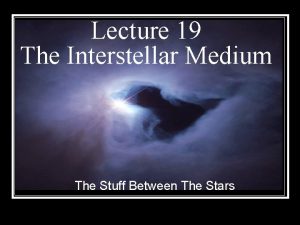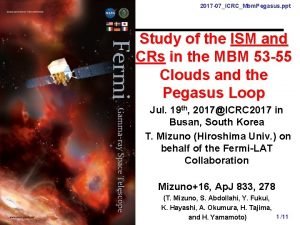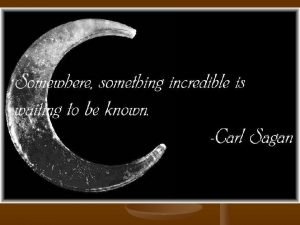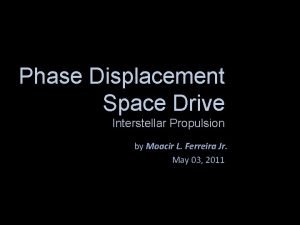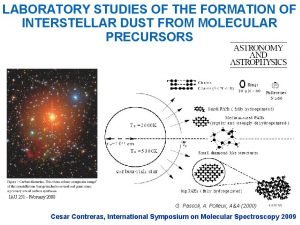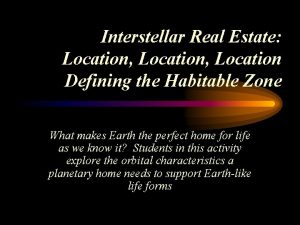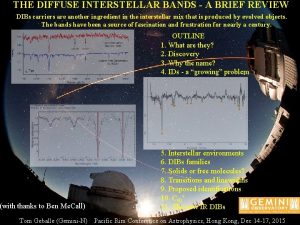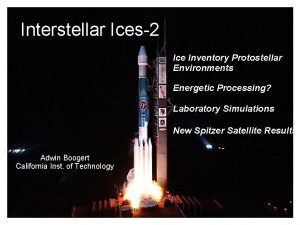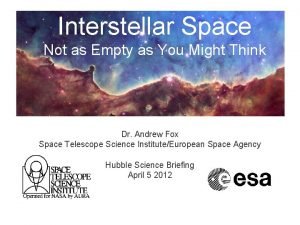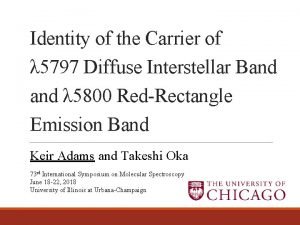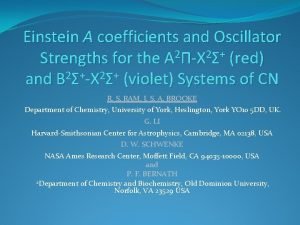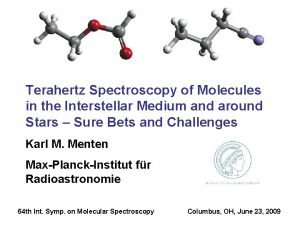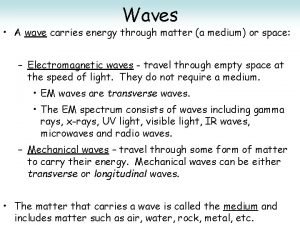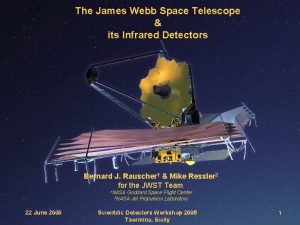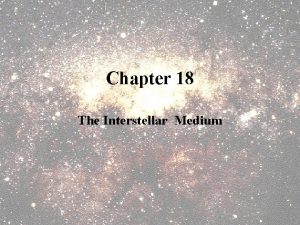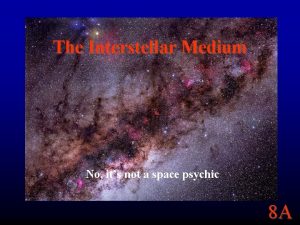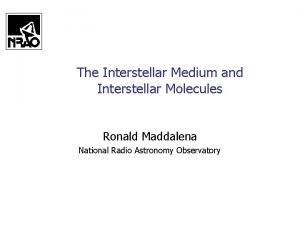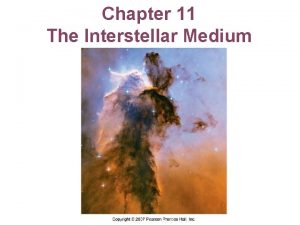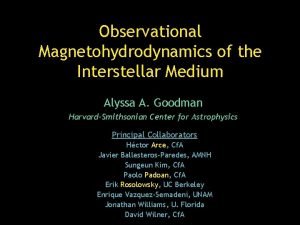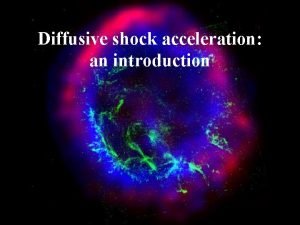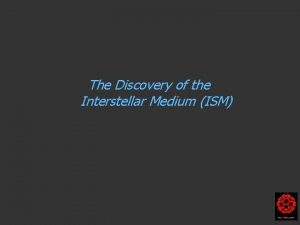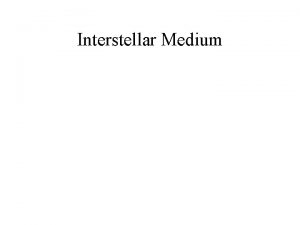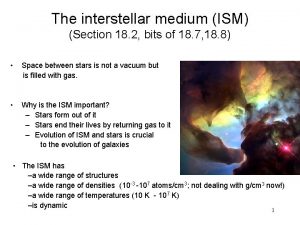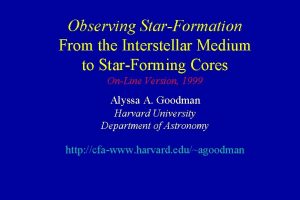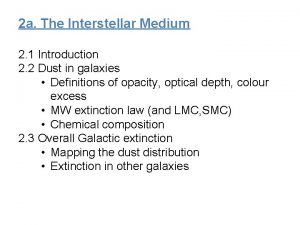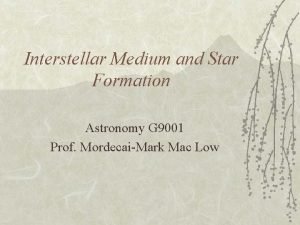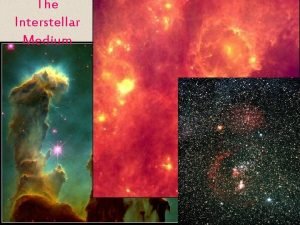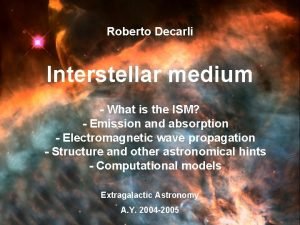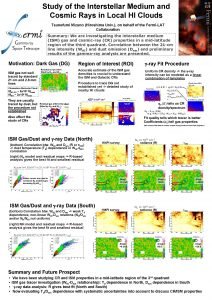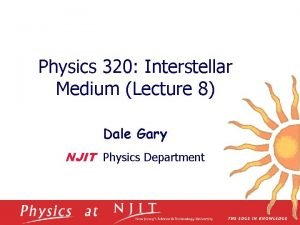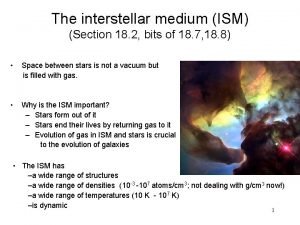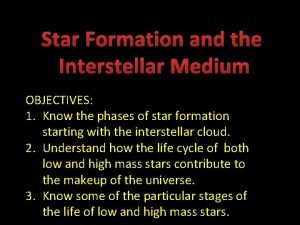The Interstellar Medium No its not a space

































- Slides: 33

The Interstellar Medium No, it’s not a space psychic 8 A

Goals • • What is the interstellar medium? What are dust clouds? What are nebulae? How do these lead to the formation of star? – Where do baby stars come from? 8 A

The Stuff Between Stars • Space isn’t empty. • Interstellar Medium – The gas and dust between the stars. All the interstellar gas and dust in a volume the size of the Earth only yields enough matter to make a pair of dice. 8 A

The Distribution • Picture the dust under your bed. – Fairly uniform thin layer – Some small clumps – Occasional big complexes • Interstellar dust and gas is the same. 8 A

Dust • Space is dirty. • Dust blocks or scatters some light. • Result: black clouds and patterns against the background sky. • But what light gets through, and what light doesn’t? 8 A

Absorption and Scattering • Q: Why are sunsets red? • Light is absorbed or scattered by objects the same size or smaller than its wavelength. • Dust grains = wavelength of blue light • Dust clouds: – Opaque to blue light, UV, X-rays – Transparent to red light, IR, radio • A: Whenever there is a lot of dust between you and the Sun, the blue light is absorbed or scattered leaving the only the red light. 8 A

Interstellar Reddening • Same thing with dust clouds in space. • Since space is full of dust, the farther away stars are, the redder they look. • Enough dust and eventually all visible light is scattered or absorbed. 8 A

Dust and IR • In a dark dust cloud: – Even though all visible light may be gone, we can still use IR. – If dust is warm, IR will show its blackbody emission. 8 A

And allows us to see dust where we wouldn’t otherwise expect it. 8 A

Scattered light • Q: But what happens to the blue light that is scattered? • A: Reflection nebulae. The Witchhead Nebula 8 A

The Trifid Nebula – copyright Jason Ware 8 A

Interstellar Gas • In lecture 2 B we talked about Kirchhoff’s laws and how they apply to hot and cool gases. • Let’s look at some hot and cool gases in space. Ha emission nebulae Copyright - Jason Ware 8 A

Horsehead Nebula – copyright Arne Henden Dust obscuring Ha emission nebula 8 A

Orion Nebula – copyright Robert Gendler • In order for the hydrogen to emit light, the atoms must be in the process of being excited. • The energy for the excitation comes from very hot stars (O and B stars) within the cloud. 8 A

Cold Dark Clouds • If dust clouds block light, then inside thick dust clouds there should be no light at all. • Without light, there is little energy. • With little energy, any gas inside is very, very cold. • Inside molecules can form. 8 A

Gravity vs. Pressure • Stars and other interstellar material are in a perpetual battle between forces pushing in (gravity) and forces pushing out (pressure). • Gravity comes from the mass of the cloud or star. • Pressure comes from the motion of the atoms or molecules. – Think of hot air balloons. – The hotter the air, the bigger the balloon. 8 A

Star Formation • Remember lecture 2 A: HOTTER COOLER • Cold interstellar clouds: No heat = no velocity = no outward pressure. Gravity wins. • Gas begins to contract. 8 A

How to Make a Star 8 A

1. The Interstellar Cloud • • Cold clouds can be tens of parsecs across. Thousands of times the mass of the Sun. Temperatures 10 – 100 K. In such a cloud: – If a star’s worth of matter should clump together in a denser region than the rest of the cloud: – Gravitational attraction will win out over their combined pressure. – The clump will begin to collapse. – The cold cloud will fragment. • Time: A few million years. 8 A

Orion Nebula – copyright Robert Gendler 8 A

2. Contracting Fragments • A fragment about the same mass as the Sun slowly contracts due to its gravity. • Now a few hundredths of a parsec across or 100 times the size of the Solar System. • Temperature still about the same. • In the center some heat begins to be retained. • Time: several tens of thousands of years. 8 A

Eagle Nebula – copyright J. Hester 8 A

3. Continued Contraction • Fragment now a gaseous sphere. • Size of the Solar System – (10, 000 x the size of the Sun) • Inner region is dense enough to be opaque to light (remember the convection zone of Sun). – Result: inner region heats up – 10, 000 K. – Outer edge still cool. • The central opaque part is called a protostar. • Mass increases as material rains down on it. • Time: 100, 000 years 8 A

• Visible and IR image of the hot protostars in the Orion Nebula. 8 A

4. Protostellar Evolution • • Gravity is still winning. The protostar is still shrinking. Size: Mercury’s orbit. The protostar is also still warming. – Core = 1, 000 K (recall core of Sun 15, 000 K) – Still not hot enough for nuclear fusion – Surface temp = 2000 – 3000 K (recall Sun = 5800 K) 8 A

The Evolutionary Track • Given the low temperature, the protostar has a low flux (very little energy is emitted per area of its surface). • The surface area is huge, however! • Result: Very high total luminosity (or absolute magnitude). 8 A

5. T Tauri Phase • Protostar still shrinks: 10 x the Sun. • Smaller size smaller surface area smaller luminosity. • Luminosity = 10 x the Sun • Still heats up: surface = 4000 K • Core temp = 5, 000 K • Violent surface activity creates strong winds that blow material away near the protostar’s surface. 8 A

8 A

6. A Star is Born • Time: 6 million years since the protostar formed (Stage 3). • Radius: 1, 000 km (Recall the Sun = 700, 000 km) • Core temp: 10, 000 K (Sun = 15, 000 K) – Surface temp = 4500 K • Fusion begins in core. • Energy released creates the pressure needed to almost counter the contraction from gravity. 8 A

7. The Main Sequence • Time: 30 million years since Stage 6. • Central temp is finally 15, 000 K • Pressure from energy of fusion balances gravity – Contraction ends • Surface temp is now 6000 K • While it took 40 – 50 million years to get here, the new star will spend the next 10 billion years as a main sequence star. 8 A

Now what? • The mass of the star that is formed will determine the rest of its life! • Recall: the more massive the star, the more pressure in the core. • The more pressure, the more fusion. • More fusion: – More energy produced – Hotter – Shorter life span 8 A

Open Clusters • These are the new stars. • Small groups of young stars. • Slowly drifting apart. Jewel Box – copyright Michael. Bessell 8 A

8 A
 What is the interstellar medium
What is the interstellar medium Interstellar medium ppt
Interstellar medium ppt Hot and cold media examples
Hot and cold media examples Medium medium 35m newton
Medium medium 35m newton Its not easy but its worth it
Its not easy but its worth it Interstellar
Interstellar Interstellar google drive
Interstellar google drive Interstellar isabella
Interstellar isabella Interstellar
Interstellar Interstellar realty
Interstellar realty Diffuse interstellar bands
Diffuse interstellar bands Interstellar
Interstellar What is interstellar travel
What is interstellar travel Diffuse interstellar bands
Diffuse interstellar bands Diffuse interstellar bands
Diffuse interstellar bands Interstellar
Interstellar Not genuine, not true, not valid
Not genuine, not true, not valid Difference between mechanical and electromagnetic waves
Difference between mechanical and electromagnetic waves A wave carries
A wave carries Unscented trajectory chapter 5
Unscented trajectory chapter 5 Space junk the space age began
Space junk the space age began Camera space to world space
Camera space to world space Cartesian space vs joint space
Cartesian space vs joint space World space computer
World space computer James webb nasa space telescope launch
James webb nasa space telescope launch Emigree poem
Emigree poem When a train increases its velocity its momentum
When a train increases its velocity its momentum Windy cloudy rainy sunny
Windy cloudy rainy sunny If its square its a sonnet
If its square its a sonnet Its halloween its halloween the moon is full and bright
Its halloween its halloween the moon is full and bright Hát kết hợp bộ gõ cơ thể
Hát kết hợp bộ gõ cơ thể Slidetodoc
Slidetodoc Bổ thể
Bổ thể Tỉ lệ cơ thể trẻ em
Tỉ lệ cơ thể trẻ em
